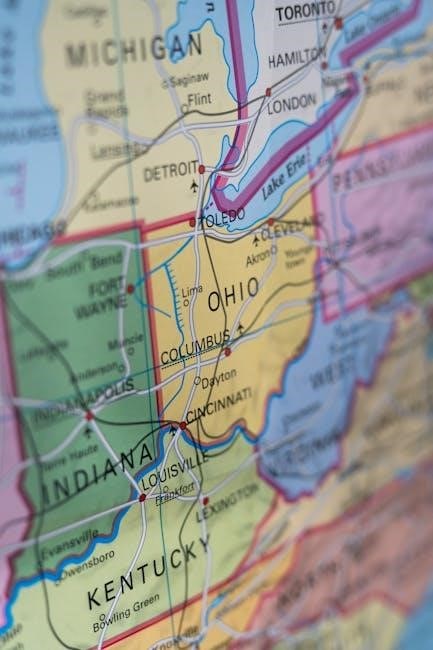Welcome to the AP Environmental Science Unit 6 Study Guide! This section introduces energy concepts, covering types, systems, and conservation strategies․ Prepare effectively for your exam with this comprehensive resource․
1․1 Overview of the Unit
Unit 6 of the APES study guide focuses on energy, covering foundational concepts and practical applications․ It explores energy types, systems, and conservation strategies, providing a comprehensive understanding of global energy challenges․ Key topics include fossil fuels, renewable energy sources, energy efficiency, and international policies․ Students will analyze the environmental impacts of energy production and use, as well as strategies for sustainable energy management․ This unit prepares learners to evaluate energy systems critically and propose solutions for a more sustainable future․
1․2 Key Concepts and Topics Covered
This unit covers essential energy concepts, including types of energy, energy flow, and systems․ It delves into energy conservation and transformation, fossil fuels, and renewable energy sources․ Key topics also include energy policy, efficiency, and conservation strategies․ Students will explore the environmental impacts of energy production and use, as well as global energy challenges․ The unit emphasizes sustainable practices and innovative solutions to energy-related issues, preparing learners to critically evaluate energy systems and propose effective solutions for a sustainable future․
1․3 Importance of the Unit in AP Environmental Science
Unit 6 is a cornerstone of AP Environmental Science, focusing on energy systems and their environmental implications․ It bridges the gap between human activities and ecological impacts, emphasizing the critical role of energy in sustainability․ Understanding energy flow, conservation, and policy is essential for addressing climate change and resource management․ This unit equips students with the knowledge to evaluate energy systems, advocate for renewable resources, and develop sustainable solutions․ Mastery of these concepts is vital for success on the AP exam and for tackling real-world environmental challenges effectively․

Energy Basics
Energy is the ability to do work, fundamental to all systems․ Explore its types, flow, and transformations, crucial for understanding environmental interactions and sustainable practices․

2․1 Definition and Types of Energy
Energy is the ability to perform work, a fundamental concept in environmental science․ It exists in various forms, including kinetic (energy of motion), potential (stored energy), thermal (heat), electrical (energy from moving charges), chemical (stored in bonds), and nuclear (energy from atomic reactions)․ Understanding these types is crucial for analyzing energy systems and environmental impacts․ Renewable and non-renewable sources of energy are also explored, emphasizing their roles in ecosystems and human activities․ This section lays the groundwork for examining energy flow and conservation in Unit 6․

2․2 Energy Flow and Systems
Energy flow refers to the transfer of energy through ecosystems, typically beginning with solar energy captured by producers․ In ecosystems, energy flows unidirectionally from one trophic level to the next, with only about 10% of energy transferred at each level due to losses as heat․ Energy systems, such as power grids and transportation networks, distribute energy for human use․ Understanding energy flow and systems is critical for analyzing efficiency, conservation, and environmental impacts․ This section explores how energy moves through natural and human-made systems, emphasizing the importance of sustainability and reducing energy waste․ It also highlights strategies to optimize energy distribution and use․
2․3 Energy Conservation and Transformation
Energy conservation involves reducing energy waste and improving efficiency to extend resource availability․ Transformation refers to converting energy from one form to another, such as coal to electricity․ The first law of thermodynamics states energy cannot be created or destroyed, only transformed․ However, the second law highlights energy quality degradation during transformations․ Conservation strategies include improving insulation, upgrading to energy-efficient technologies, and promoting renewable sources․ Understanding these principles is vital for sustainable energy use and reducing environmental impacts․ This section explores practical applications of energy conservation and transformation in both natural systems and human activities, emphasizing their role in meeting global energy demands responsibly․

Fossil Fuels and Their Impact
Fossil fuels, including coal, oil, and natural gas, are formed from ancient organisms․ Their extraction and use cause pollution and contribute significantly to climate change․
3․1 Coal, Oil, and Natural Gas: Formation and Uses
Coal, oil, and natural gas are fossil fuels formed from ancient plant and marine life over millions of years․ Coal primarily forms from terrestrial plants, while oil and gas originate from marine organisms․ These fuels are extracted through mining and drilling․ Coal is widely used for electricity generation, industrial processes, and heating․ Oil is refined into gasoline, diesel, and other products for transportation and industrial applications․ Natural gas, composed mostly of methane, is used for heating, electricity generation, and as a feedstock in chemical production․ Their formation and uses are central to understanding energy systems and environmental impacts․
3․2 Environmental Impacts of Fossil Fuel Extraction and Use
Fossil fuel extraction and use significantly harm the environment․ Mining and drilling disrupt ecosystems, causing land degradation and water contamination․ Air pollution from combustion releases greenhouse gases like CO2 and methane, driving climate change․ Oil spills and accidents during extraction further devastate marine life․ Additionally, fossil fuels contribute to acid rain and smog, affecting human health and ecosystems․ These impacts highlight the urgent need for sustainable alternatives to mitigate environmental damage and promote a healthier planet․ Understanding these effects is crucial for developing strategies to reduce reliance on fossil fuels․
3․3 Role of Fossil Fuels in Climate Change
Fossil fuels play a central role in climate change due to their significant contribution to greenhouse gas emissions․ Burning coal, oil, and natural gas releases carbon dioxide and methane, which trap heat in the atmosphere, exacerbating global warming․ These emissions are a major driver of rising temperatures, melting ice caps, and extreme weather events․ The extraction and use of fossil fuels also disrupt ecosystems, contributing to biodiversity loss and environmental degradation․ Addressing climate change requires reducing reliance on fossil fuels and transitioning to cleaner energy sources to mitigate their harmful effects on the planet․ This section explores the critical link between fossil fuels and climate change impacts․

Renewable Energy Sources
Renewable energy sources are crucial for sustainability, offering clean alternatives to fossil fuels․ This section explores solar, wind, hydroelectric, biomass, and geothermal energy, highlighting their benefits and challenges․
4․1 Solar, Wind, and Hydroelectric Power
Solar, wind, and hydroelectric power are leading renewable energy sources․ Solar energy harnesses sunlight through panels, offering abundant and emissions-free power․ Wind energy uses turbines to convert moving air into electricity, ideal for open, windy regions․ Hydroelectric power generates energy from flowing water, such as rivers or dams, providing consistent and scalable electricity․ These sources are sustainable, reducing reliance on fossil fuels and lowering greenhouse gas emissions․ However, their availability depends on location and weather conditions, requiring careful planning for implementation and energy storage solutions to ensure reliability․

4․2 Biomass and Geothermal Energy

Biomass energy comes from organic materials like plants, wood, and waste, which are burned to produce electricity or heat․ It is renewable and reduces landfill waste, offering a carbon-neutral alternative․ Geothermal energy harnesses heat from the Earth’s core to generate electricity, providing a stable and reliable power source․ Both technologies contribute to reducing greenhouse gas emissions․ However, biomass production requires significant land and water, and geothermal plants are limited to specific geographic locations․ Despite these challenges, they play crucial roles in diversifying the renewable energy portfolio and promoting sustainability․ Proper planning is essential to maximize their potential and minimize environmental impacts․
4․3 Benefits and Challenges of Renewable Energy
Renewable energy offers numerous benefits, including reduced greenhouse gas emissions, enhanced energy security, and lower operational costs over time․ It also promotes job creation and supports local economies․ However, challenges such as intermittency, high initial costs, and land-use concerns persist․ Solar and wind rely on weather conditions, while biomass and geothermal face geographical limitations․ Additionally, large-scale installations may conflict with ecosystems․ Despite these hurdles, advancements in technology and policy support are addressing these issues, making renewables increasingly viable for widespread adoption and contributing significantly to global energy transitions and sustainability goals․

Energy Policy and International Agreements
Explore global energy policies, international treaties, and agreements aimed at promoting sustainable energy use and reducing climate change impacts, such as the Paris Agreement and UN initiatives․
5․1 Global Energy Policies and Initiatives
Global energy policies and initiatives aim to address climate change, promote sustainability, and ensure energy security․ The Paris Agreement, a landmark international treaty, seeks to limit global warming by reducing greenhouse gas emissions․ Countries like Germany, with its Energiewende program, and India, through its National Solar Mission, demonstrate national-level commitments to renewable energy․ Organizations like the United Nations and the European Union play pivotal roles in fostering cooperation and setting energy goals․ These policies often include incentives for clean energy technologies, carbon pricing mechanisms, and strategies to phase out fossil fuels․ Such initiatives highlight the global shift toward sustainable energy systems and the importance of international collaboration in achieving climate objectives․ Technological advancements and policy frameworks are critical in driving this transition․
5․2 Role of International Treaties in Energy Regulation
International treaties play a crucial role in shaping global energy regulation by establishing frameworks for cooperation and accountability․ Agreements like the Paris Agreement and the Kyoto Protocol set targets for reducing greenhouse gas emissions and promoting renewable energy adoption․ These treaties often include mechanisms such as carbon pricing and emissions trading to incentivize compliance․ They also provide platforms for countries to share technologies and strategies, ensuring a unified approach to energy challenges․ By fostering international collaboration, these treaties help balance economic development with environmental protection, ensuring sustainable energy practices and mitigating climate change impacts․ Their implementation is vital for achieving global energy and climate goals․
5․3 Case Studies: Successful Energy Policies
Examining successful energy policies through case studies provides insights into effective strategies for sustainable energy transitions․ Germany’s Energiewende, for instance, highlights a comprehensive shift toward renewable energy through subsidies and grid modernization․ Similarly, Norway’s incentives for electric vehicles have significantly reduced emissions․ Costa Rica’s commitment to reforestation and renewable energy exemplifies a balanced approach to energy and environmental goals․ These case studies demonstrate how policy design, public-private partnerships, and technological investments can drive impactful change․ By analyzing these successes, nations can replicate strategies tailored to their contexts, fostering global energy sustainability and climate resilience while addressing unique regional challenges and opportunities․

Energy Efficiency and Conservation
Energy efficiency and conservation are crucial for reducing energy consumption and mitigating environmental impacts․ This section explores strategies to optimize energy use and promote sustainable practices effectively․
6․1 Strategies for Reducing Energy Consumption
Reducing energy consumption involves practical strategies to minimize waste and optimize usage․ Improving insulation, upgrading to LED lighting, and using energy-efficient appliances are effective methods․ Smart grid technologies and renewable energy sources also play a role in reducing overall demand; Behavioral changes, such as turning off unused devices and adjusting thermostat settings, contribute significantly․ Implementing these strategies not only lowers energy costs but also supports environmental sustainability by reducing greenhouse gas emissions․ Understanding these approaches is essential for developing sustainable energy practices in both individual and societal contexts․
6․2 Technological Innovations in Energy Efficiency
Technological advancements are transforming energy efficiency across industries and households․ Smart grids optimize energy distribution, reducing waste and improving reliability․ LED lighting and energy-efficient appliances significantly lower consumption․ Smart thermostats and automated energy management systems enable real-time monitoring and adjustments․ Building materials with enhanced insulation properties reduce heating and cooling needs․ These innovations not only conserve resources but also align with global sustainability goals, reducing greenhouse gas emissions․ By integrating cutting-edge technologies, societies can achieve higher energy efficiency, supporting a cleaner and more sustainable future while meeting growing energy demands․
6․3 Behavioral Changes for Sustainable Energy Use
Behavioral changes play a crucial role in achieving sustainable energy use․ Simple actions, such as turning off lights or electronics when not in use, can significantly reduce energy consumption․ Encouraging individuals to adopt energy-conscious habits, like using public transport or carpooling, helps lower overall energy demand․ Education and awareness campaigns are key to promoting these practices․ Communities can also benefit from initiatives that foster a culture of conservation․ By prioritizing sustainability in daily choices, individuals contribute to a larger collective impact, supporting global efforts to combat climate change and promote energy efficiency․
Mastering Unit 6 requires understanding energy systems, conservation, and sustainability․ Use practice questions and review resources to reinforce concepts․ Stay organized and focused for exam success․
7․1 Summary of Key Points
Unit 6 of the APES study guide covers energy systems, focusing on fossil fuels, renewable sources, and sustainability․ Key concepts include energy transformation, conservation, and environmental impacts․ Students explore energy policy, technological innovations, and behavioral changes for efficient use․ Understanding the transition from fossil fuels to renewables is crucial, alongside strategies to reduce consumption․ The unit emphasizes global policies and treaties regulating energy use․ Effective study involves practice questions, flashcards, and review resources to master these topics for exam success․
7․2 Effective Study Strategies for Unit 6
To excel in Unit 6, focus on active recall and spaced repetition․ Use flashcards for key terms like energy types and policies․ Practice past exam questions to familiarize yourself with the format․ Organize notes into concept maps or summaries to visualize relationships between topics․ Engage with digital tools like Quizlet for interactive learning․ Join study groups to discuss complex concepts like renewable energy challenges and energy conservation․ Regularly review and apply real-world examples to reinforce theoretical knowledge․ Dedicate time to understanding graphs and data interpretations, as they are critical for analysis questions․ Stay consistent and adjust your strategy based on progress․
7․3 Practice Questions and Review Resources
Enhance your preparation with practice questions that simulate exam conditions․ Focus on multiple-choice and free-response questions covering energy systems, policies, and conservation․ Utilize online platforms like Quizlet for flashcards and practice tests․ Review official study guides and past exams to familiarize yourself with question formats․ Explore Khan Academy and AP Classroom for video tutorials and interactive exercises․ Additionally, consult teacher-provided resources, such as unit-specific review sheets and concept checklists․ Regularly test yourself on topics like renewable energy and fossil fuel impacts to identify weak areas․ Prioritize timed practice to build exam stamina and accuracy․
